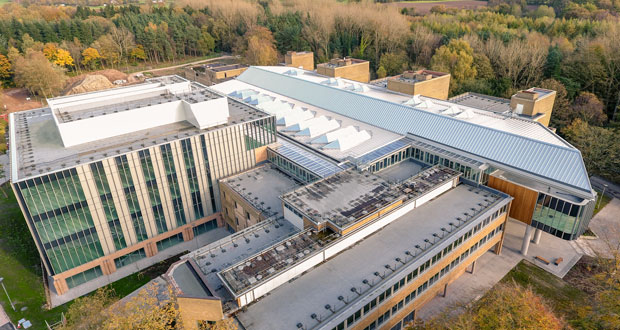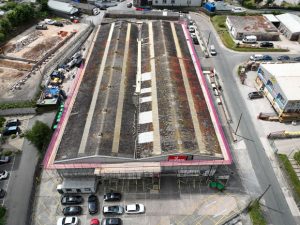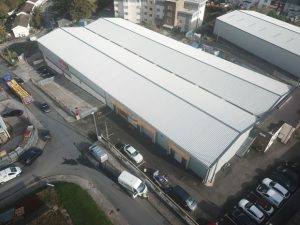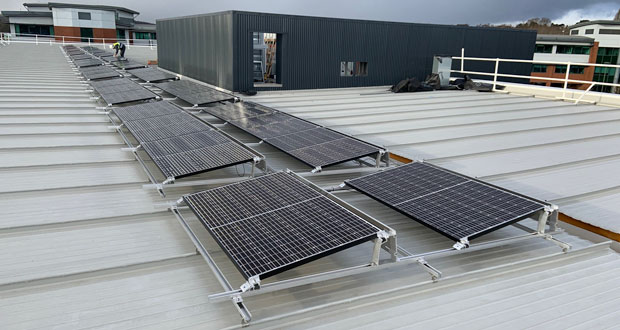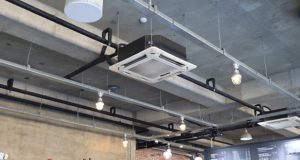 A well-designed and maintained roof is critical to a building’s energy efficiency and operational carbon reduction. In this article, Garland UK Technical Manager Andrew Fox explores the benefits of prioritising the retrofit of existing roofing assets, emphasising the substantial savings that can be made on resource use and embodied carbon.
A well-designed and maintained roof is critical to a building’s energy efficiency and operational carbon reduction. In this article, Garland UK Technical Manager Andrew Fox explores the benefits of prioritising the retrofit of existing roofing assets, emphasising the substantial savings that can be made on resource use and embodied carbon.
Understanding Your Roof’s Health
Retrofitting a commercial roof presents a cost-effective solution compared to completely replacing the entire roof system. Through targeted interventions, retrofitting will significantly reduce material and labour costs by using existing infrastructure while addressing specific issues, such as water ingress or insulation problems. Additionally, the time required for retrofitting is generally less than for complete replacement since it does not involve extensive demolition. This cost-saving approach allows facilities managers and organisations to allocate budgets more efficiently without compromising quality or performance.
Understanding the roof performance is a critical first step in assessing the existing build-up’s lifespan and waterproofing condition before undertaking retrofitting works. A detailed roof condition survey will mitigate unexpected issues and provide precise data and evidence for your business case for retrofit works.
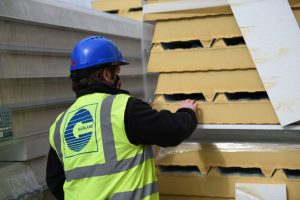 At Garland UK, local Technical Managers will assess the condition of commercial roofs to provide a comprehensive report and photographic evidence of their findings. A typical survey would include a roof life span assessment, roofing defects analysis, u-value calculations, core sampling and moisture mapping surveys to isolate any areas of water ingress.
At Garland UK, local Technical Managers will assess the condition of commercial roofs to provide a comprehensive report and photographic evidence of their findings. A typical survey would include a roof life span assessment, roofing defects analysis, u-value calculations, core sampling and moisture mapping surveys to isolate any areas of water ingress.
Navigating Non-domestic EPC Requirements
Understanding the relevant Energy Performance Certificate (EPC) requirements is key when retrofitting a commercial property, providing vital information about a building’s efficiency and any necessary insulation upgrades.
EPCs are required whenever a sale or rental of a building is agreed upon and when a new commercial building is to be built. They contain information about the energy used in a building and rate the energy efficiency using an alphabetical scale of A-G (where A is the highest, most efficient, and G is the lowest). The assessment also provides recommendations for improving energy efficiency. Alongside this rating, the certificate contains valuable insights into how energy is used within the building and further suggestions for improving its efficiency.
An accredited accessor can provide you with an EPC. They’ll closely examine various aspects of the building, evaluating the insulation, heating systems, lighting, and ventilation. Based on this evaluation, they’ll assign the building its energy efficiency EPC rating.
As of April 1st, 2023, Minimum Energy Efficiency Standards (MEES) require privately rented non-domestic properties to have an EPC rating of E or above. Commercial EPC ratings will be increased to a ‘C’ rating by 1 April 2027 and a ‘B’ rating by 1 April 2030.
Future minimum EPC ratings have required landowners to plan ahead, and properties that do not meet the minimum EPC ratings will eventually need significant upgrades to achieve compliance. The cost of EPC non-compliance is substantial, where commercial landowners could face a fine of up to £150,000 per breach.
Before and after images
Maximising Energy Savings with Solar PV
Facilities managers and organisations looking to improve their building’s energy efficiency should consider installing photovoltaic (PV) panels during a roof renovation. Before proceeding with this option, it is crucial to ensure that the roof is suitable for solar installation in terms of size, structural integrity, and safe access for regular maintenance.
Installing PV systems on your roof can have significant benefits. Not only can they reduce operational carbon emissions, but they also provide an alternative source of electricity and offer greater energy security. Solar PV systems offer a relatively short payback period of as little as 4 years, and with proper maintenance, they have a life expectancy of 20-25 years.
When planning for preventative maintenance or major works on your building, it is best to undertake roof retrofit works simultaneously with upgrades to insulation and installation of PV panels. This approach allows for shared costs and maximises the value and return on investment in a shorter timeframe.
Additionally, grouping these works reduces the risk of voiding any warranties or guarantee conditions associated with a new roof. If you were to return to add PV or insulation later after recovering your roof under warranty, there is potential for damaging the newly installed covering. By considering these factors and incorporating PV panel installation into your roof renovation, you can improve your building’s energy efficiency while maximising the return on investment.
Adopting Best Practices
The importance of retrofitting commercial roofs cannot be overstated in the context of energy efficiency and carbon reduction, where commercial buildings can realise significant cost savings, reduced environmental impact, and improved energy performance, all of which are crucial for meeting the UK’s net-zero targets.
Understanding your roof’s condition through comprehensive surveys is essential to identify the most effective retrofit solutions. As the market increasingly favours energy-efficient buildings, retrofitting offers commercial landlords a competitive edge by attracting tenants willing to pay a premium for green credentials. Additionally, incorporating solutions like photovoltaic panels during roof renovations can further enhance energy savings and return on investment.
Ultimately, retrofitting commercial roofs is not just a matter of compliance or cost-saving; it is a strategic move towards more sustainable buildings in an evolving regulatory landscape. By adopting best practices and focusing on low-carbon solutions, building owners can significantly reduce operational emissions and foster a more sustainable built environment for future generations.

